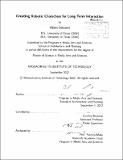Creating robotic characters for long-term interaction
Author(s)
Setapen, Adam (Adam Michael)
DownloadFull printable version (27.00Mb)
Other Contributors
Massachusetts Institute of Technology. Dept. of Architecture. Program in Media Arts and Sciences.
Advisor
Cynthia Breazeal.
Terms of use
Metadata
Show full item recordAbstract
Researchers studying ways in which humans and robots interact in social settings have a problem: they don't have a robot to use. There is a need for a socially expressive robot that can be deployed outside of a laboratory and support remote operation and data collection. This work aims to fill that need with DragonBot - a platform for social robotics specifically designed for long-term interactions. This thesis is divided into two parts. The first part describes the design and implementation of the hardware, software, and aesthetics of the DragonBot-based characters. Through the use of a mobile phone as the robot's primary computational device, we aim to drive down the hardware cost and increase the availability of robots "in the wild". The second part of this work takes an initial step towards evaluating DragonBot's effectiveness through interactions with children. We describe two different teleoperation interfaces for allowing a human to control DragonBot's behavior differing amounts of autonomy by the robot. A human subject study was conducted and these interfaces were compared through a sticker sharing task between the robot and children aged four to seven. Our results show that when a human operator is able to focus on the social portions of an interaction and the robot is given more autonomy, children treat the character more like a peer. This is indicated by the fact that more children re-engaged the robot with the higher level of autonomy when they were asked to split up stickers between the two participants.
Description
Thesis (S.M.)--Massachusetts Institute of Technology, School of Architecture and Planning, Program in Media Arts and Sciences, 2012. Cataloged from PDF version of thesis. Includes bibliographical references (p. 177-181).
Date issued
2012Department
Program in Media Arts and Sciences (Massachusetts Institute of Technology)Publisher
Massachusetts Institute of Technology
Keywords
Architecture. Program in Media Arts and Sciences.